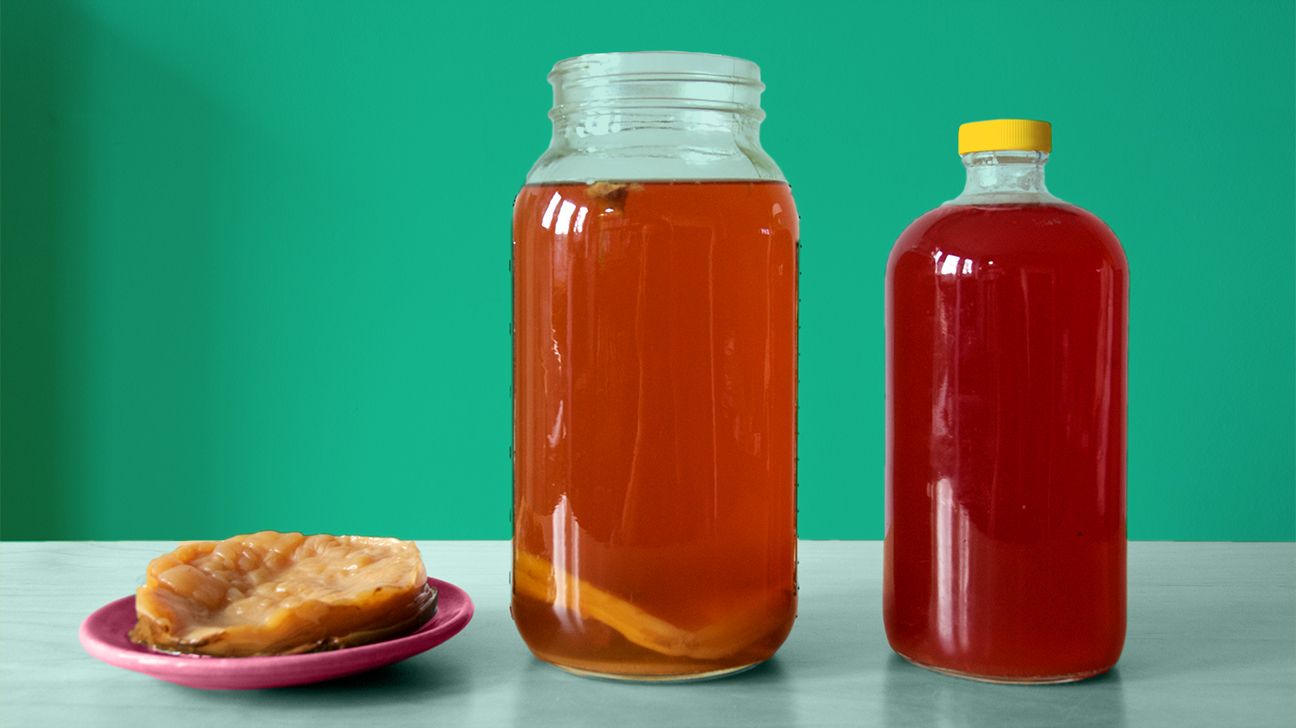Kambucha is praised for its gut-friendly qualities, but does it have caffeine? If you’re thinking about swapping it in for your usual coffee or tea, here’s what to keep in mind.
Products claiming to pamper your “gut microbiome” get so much buzz — and for good reason! A healthy gut can boost your mental health, make your skin glow, and have many other benefits.
Kombucha is one of the trendiest tonics for a healthy gut. It’s no secret that there’s a bit of alcohol in kombucha, but what about caffeine? Could kombucha replace your favorite glass of red and your morning cuppa?
What even is kombucha?
Kombucha — which fans also lovingly call ’bucha — is fermented tea. Though it’s hyped as a new wellness bevvy, kombucha dates back to ancient China, where people sipped it as a possible remedy for many conditions, including arthritis and cancer.
Kombucha’s fermentation process makes it a probiotic gold mine, bubbling with healthy organisms. (Mmmm.)

TBH, that’s kind of a trick question.
According to an interview with dietitians in Time magazine, about one-third of a tea’s caffeine content remains after fermentation. So, kombucha’s caffeine depends on its OG tea type — calming green brew or powerhouse black tea blend?
Let’s do some math:
The FDA reports that 8 oz of the average tea has 30–50 mg of caffeine. That means an 8-oz bottle of kombucha could contain anywhere from 10–15 mg of caffeine, or even more if producers start with a strong brew.
How can you tell which brands pack a punch?
Well… maybe you can’t. Some major manufacturers print caffeine content on the label, but not all do. And the small-batch bottlers at your local market probably don’t have equipment precise enough to measure milligrams of caffeine.
If you’re sensitive to caffeine, drinking kombucha is kind of a “consume at your own risk” affair.
Kombucha’s power to jolt you awake is directly related to the tea used to make it.
Tea tends to provide a gentler, slower boost than coffee or energy drinks. That’s because there are 25 to 30 milligrams of caffeine in a cup of tea, as compared to 75 to 80 milligrams in a cup of coffee.
FYI, the FDA recommends limiting your caffeine consumption to 400 milligrams per day. That’s about 5 cups of coffee or 13 cups of tea. You can drink a lot of kombucha without hitting that limit.
Kombucha producers also play around with caffeine content in a few ways:
- steeping the tea in hot liquid longer = more caffeine
- fermenting the kombucha longer = less caffeine
- added natural caffeine content = more caffeine (Yep, some makers add caffeine after fermenting, so read labels carefully!)
How do manufacturers or DIY-ers transform ordinary tea into an effervescent elixir? It’s pretty simple.
Regardless of the brand, kombucha starts with a custom mixture of three things:
- sugar
- tea (usually black or green)
- specific strains of yeast and bacteria
Once combined, this tasty trio sits at room temp for at least a week — and up to 30 days — to let the yeast, bacteria, and sugar ferment.
Through fermentation, the bacterial composition changes, adding three new ingredients to the scene:
- alcohol
- acetic acid
- carbon dioxide
Fair warning:
Fermentation also produces some literal funk — a jiggly, mushroom-like growth called SCOBY (symbiotic colony of bacteria and yeast). Producers skim off the SCOBY before bottling kombucha for drinking.
If you want to start sipping kombucha on the reg without ditching your other caffeine habits, follow these tips to avoid going overboard.
1. Choose wisely
Making your own ’bucha? Stick with decaf or low caf (40 to 60 milligrams of caffeine) teas as your base brew.
Look for decaf teas with carbon dioxide or water processing instead of methyl chloride decaffeination, which can disrupt fermentation.
2. Reduce steeping time
Less steeping = less caffeine. Soaking your tea bag or tea leaves for 5 to 10 minutes produces full flavor with limited caffeine content.
Bonus tip: Slightly cooler water (y’know, not boiling) could also reduce caffeine content since hot temps speed up absorption.
3. Peep your labels
In the world of kombucha, caffeine isn’t the first priority. You’ll need to study bottle labels closely to find the caffeine content, especially if the brand uses intricate or busy graphics.
Still, big brands like GT and Health-Ade do list caffeine facts somewhere on the bottle. Several companies list it near the brand or flavor name.
4. Check the full ingredient list
Sugar, other flavorings, or additional fermented ingredients like apple cider vinegar can sometimes affect kombucha’s caffeine concentration.
Research also indicates that nicotine — whether from the gum or a cig — makes your body process caffeine faster.
5. Sip less
This one’s a no-brainer, but it’s still true: Less kombucha means less caffeine. If you’re concerned about getting jittery from kombucha, down half a bottle and then store the rest in the fridge for tomorrow. Or go halfsies with your roommate. Share the love!
Wondering if kombucha has caffeine? The short answer is: probably. But caffeine levels vary wildly depending on the brand, type of tea used, and steeping time.
If you’re sensitive to caffeine or want to cut back your intake, read the labels! Check for a note on caffeine content and for other energizing ingredients (hello, sugar!).
The best way to control caffeine intake while enjoying a ’bucha bevvy? Drink less than 8 ounces or find one specifically made with decaf tea. Cheers!

